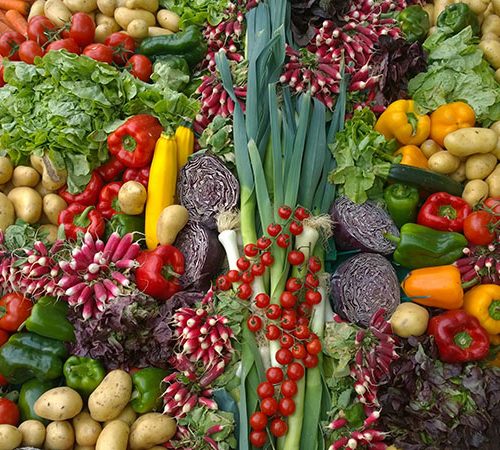To include the impacts from the coronavirus pandemic this year, Global Footprint Network combined the most reliable data and formed the most reasonable assumptions to assess humanity’s current resource situation.
Changes in carbon emissions, forest harvest, food demand, and other factors that could impact global biocapacity or the Ecological Footprint from January 1 to Earth Overshoot Day were evaluated. The main drivers were the carbon Footprint (reduced 14.5% from 2019) and the forest product Footprint (reduced 8.4% from 2019). Check out the highlights and/or the detailed research report explaining how the date of Earth Overshoot Day was calculated.
Take a Step to #MoveTheDate
We know it can be overwhelming to think about how your personal Footprint contributes to global overshoot.
The truth is, you can take steps to chip away at your impact on the planet.
Explore Solutions to #MoveTheDate
Thriving lives within the means of our planet are not out of reach. Plenty of solutions exist in five major areas
for improving sustainability: planet, cities, energy, food, and population.
How we help nature thrive
Humanity’s quality of life is dependent on the health of our planet’s biological resources including fertile soil, clean water, and clean air necessary for humanity to thrive. Learn More
How we design and manage cities
Eighty percent of the world population is expected to live in cities by 2050. City planning and urban development strategies are instrumental to balancing the supply of natural capital and population’s demand. Learn More
How we power ourselves
Decarbonizing the economy is our best possible chance to address climate change, and would improve the balance between our Ecological Footprint and the planet’s renewable natural resources. Learn More
How we produce, distribute, and consume food
How we meet one of our most basic needs–food–is a powerful way to influence sustainability. Sourcing food locally and avoiding highly processed foods can lower the Ecological Footprint. Learn More
How many of us there are
Being committed to everyone living secure lives in a world of finite resources requires addressing population growth. Empowering women is essential for global sustainability. Learn More
Blog
Partner Events
 Viernes Por El Futuro Ecuador #diadelsobregiro
Viernes Por El Futuro Ecuador #diadelsobregiro
Viernes 21 de agosto 18h00 (GMT -5)
Movilízate de forma sostenible y #MueveLaFecha. Conversatorio el mundo detrás de tu transporte
 Dia del Sobregiro de la Tierra 2020 Webinar
Dia del Sobregiro de la Tierra 2020 Webinar
August 21 at 19:00 (GMT -4)
Será sólo efecto del #covid_19 o será que hemos entendido y tomado acciones responsables para mover esta fecha? Porqué en Chile fue 18 de Mayo este año? Qué significa la huella ecológica y qué tiene que ver nuestro estilo de vida en ella? Estas y otras preguntas serán las que intentaremos resolver este viernes junto a nuestro invitado estelar, Bernardo Reyes, ecólogo y socio fundador de AdC Circular.
Webinar meet.google.com/taf-zepv-kpm
 Scottish Parliament Event
Scottish Parliament Event
August 24 at 6:00 pm CEST / 9:00 am PST
Join the Scottish conversation and explore the business case for sustainability. You are invited to join political figures as they discuss how Scotland can #MoveTheDate. Registration link coming soon. More Details Here
 Earth Overshoot Day Virtual Trivia Night
Earth Overshoot Day Virtual Trivia Night
August 25 at 4:00 pm PT / 7:00 pm ET
Test your sustainability knowledge and win great prizes! Join Global Footprint Network and the Center for Biological Diversity for #EarthOvershootDay Virtual Trivia Night! Register Here
 How to build lasting business success on a finite planet
How to build lasting business success on a finite planetAugust 27 at 3:30 pm CEST / 6:30 am PST
Reducing humanity’s ecological footprint while simultaneously improving social well-being is an economically-beneficial and robust path forward for any organization. For corporations who embrace this assumption, the cornerstone of strategy then becomes whether or not their business supports humanity’s continued success. In our upcoming webinar, featuring Mathis Wackernagel, founder of the Global Footprint Network—the organization behind Earth Overshoot Day—we will discuss how companies that prepare themselves for one-planet prosperity are better primed to attain and maintain competitive advantage and resiliency. Register Here
 Shaping the future – How do we want to live?
Shaping the future – How do we want to live?
ongoing through December 2020
How will everyday life look in the year 2040? The exhibition presents three possible futures for a world that has resolved to largely forgo fossil-based raw materials. Instead biobased resources such as plants, animals and microorganisms are used. The opportunities and risks of such a system – a bioeconomy – are shown in the exhibition.
Let yourself be inspired and be part of the exhibition: submit climate-friendly recipes or personal tips for more sustainability in order to move the date of Earth Overshoot Day. More Information
 Global Earth Overshoot Day Launch
Global Earth Overshoot Day Launch
August 20 at 5:00-6:30 PM UTC
The Scottish Environment Protection Agency (SEPA) and the University of Glasgow, in conjunction with the California based Global Footprint Network, are teaming up with Scotland’s most progressive business leaders, thinkers and young people as part of its ‘Earth Overshoot Day’ campaign. More Information
 European Earth Overshoot Day Launch
European Earth Overshoot Day Launch
August 20 at 7:00-8:00 AM UTC
The challenge of relaunching our economies presents countries with a unique chance to act on the future we want. Join The Club of Rome and Global Footprint Network for an engaging online session streamed live on YouTube. This public event will combine live engagement with video messages from ‘green champions’ throughout Europe and will bring to life what it means in practice to ‘build back better’ post-COVID. Register Here
 Global Articulation to Combat the Climate Emergency
Global Articulation to Combat the Climate Emergency
August 21 at 8:00 PM UTC
The uncontrolled growth of human activities has had numerous impacts on the planet’s climate and natural ecosystems. What transformations can help our human society improve resilience? As we seek ways to adapt to foreseeable changes ahead, the Museum of Tomorrow invites physicist and world-renown climate change expert Paulo Artaxo and economist Ana Toni, executive director of Instituto Clima e Sociedade (iCS) and founding partner of GIP (Public Interest Management). The debate will take place in Portuguese on the Museum’s YouTube channel.
By the Numbers

Earth Overshoot Day is an initiative of Global Footprint Network, an international research organization that is changing the way the world measures and manages its natural resources. The date of Earth Overshoot Day is calculated with data from Global Footprint Network’s National Footprint and Biocapacity Accounts, available for free at data.footprintnetwork.org.




































































